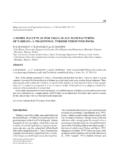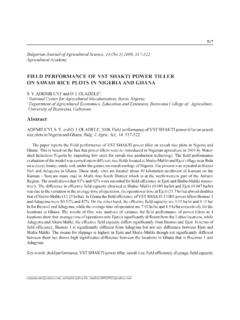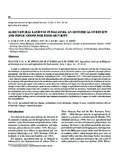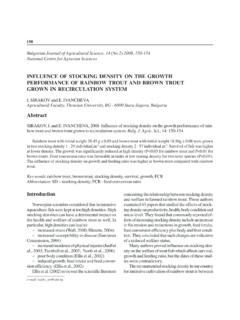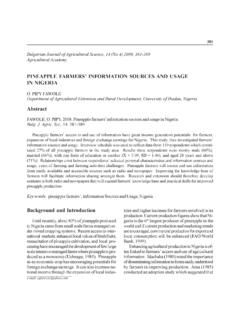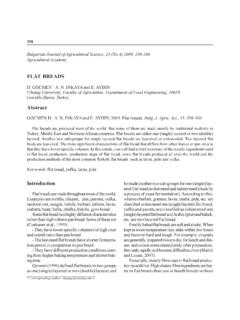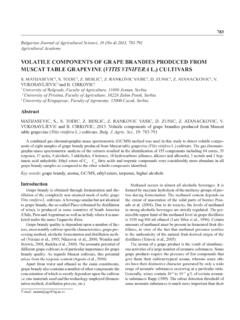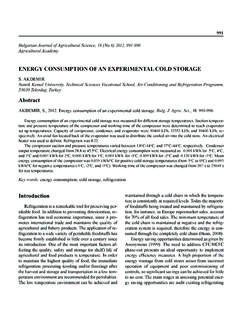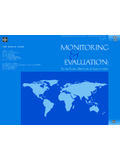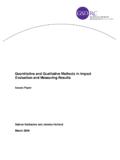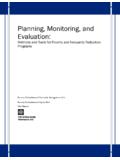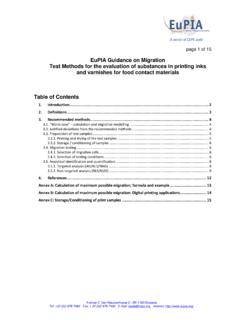Transcription of EVALUATION OF THE METHODS FOR …
1 11 EVALUATION of the METHODS for determination of the Free Radical Scavenging Activity by DPPHB ulgarian Journal of Agricultural Science, 17 (No 1) 2011, 11-24 Agricultural AcademyEVALUATION OF THE METHODS FOR DETERMINATIONOF THE FREE RADICAL SCAVENGING ACTIVITY BY DPPHG. MARINOVA* and V. BATCHVAROVI nstitute of Cryobiology and Food Technologies, BG 1407 Sofia, BulgariaAbstractMARINOVA, G. and V. BATCHVAROV, 2011. EVALUATION of the METHODS for determination of the free radical scavenging activity by DPPH. Bulg. J. Agric. Sci., 17: 11-24 The survey of the METHODS for determination of free radical scavenging activity by DPPH has been done. The differences between METHODS conditions and their EVALUATION are presented.
2 It was determined the effect of METHODS conditions by ruggedness testing of METHODS . It was specified that the accuracy of the method for determination of free radical scavenging activity is effected by the solvent used (ethanol or methanol) and the sample/reagent DPPH volume ratio. The coefficient of variation of the method with ethanol is twice lower that the respective one determined with using of methanol. The calibration curves with ascorbic acid (Vitamin C) and -Tocopherol (Vitamin E) and solvent ethanol and methanol were plotted. They are characterized with very high regression coefficients. Based on the analysis and EVALUATION of the METHODS , the results of ruggedness testing of METHODS , coefficient of variations of determination with solvent ethanol and methanol and recommendations of some authors it was proposed modification of the method for determination of free radical scavenging activ-ity of beer and beverages with DPPH.
3 The modification of the method includes: mM solution of DPPH in ethanol, reaction mixture ml diluted sample and ml DPPH solution, 30 minutes time of reaction in dark, measurement of absorbance at 517 nm, presentation of the results as equivalent of Vitamin C antioxidant activity. It was investigated the effect of malt and hops on the antioxidant activity of wort and beer. It was established that the main free radical scavenging activity of beer is attributed by the malt used. The hopping increases addition-ally the values of the parameter. During the different stages of the brewing process the free radical scavenging activity is changed. The differences between the free radical scavenging activity of laboratory and production beers indicated the very important role of raw materials and technology used.
4 The free radical scavenging activ-ity of beers determined by ethanol is higher (an average 8,2 - % for the used beer samples) than the values obtained by solvent words: method DPPH, modification of method, ethanol, methanol, malt, beerAbreviations: DPPH - 2,2-Diphenyl-1-picrylhydrazyl, BHA Butylated xydroxy anisole, BHT Bu-tylated hydroxy toluene, EVCAA equivalent vitamin C antioxidant activity, EVEAA - equivalent vitamin E antioxidant activity, FRSA free radical scavenging activity, EBC European Brewery ConventionCorresponding author: Marinova* and V. BatchvarovIntroductionThere is great number of METHODS for determi-nation of antioxidant capacity of foods and bever-ages based on different principles: peroxyl radical scavenging (Oxygen Radical Absorbance capacity, ORAC); Total Radical-trapping Antioxidant Power (TRAP); metal reducing power (Ferric Reducing Antioxidant Power, FRAP); Cupric Reducing Antioxidant Power (CUPRAC); hydroxyl radical scavenging (deoxiribose assay); organic radical scavenging (2,2-Azino-bis(3-ethylbenz-thiaz-oline-6 -sulfonic acid, ABTS); 2,2-Diphenyl-1-picrylhydrazyl, DPPH); quantification of the prod-ucts formed during the lipid peroxidation (Thio-barbituric Acid Reactive Substances, TRAPS); Low-density Lipoproteins (LDLs) oxidation, etc.
5 (P rez-Jim nez and Saura-Calixto, 2008). The most widely-used procedures for measurement of antioxidant capacity are FRAP, ABTS, TEAC (Trolox equivalent antioxidant capacity) , DPPH and ORAC (P rez-Jim nez et al., 2008).The DPPH method is rapid, simple, accurate and inexpensive assay for measuring the abil-ity of different compounds to act as free radical scavengers or hydrogen donors, and to evaluate the antioxidant activity of foods and beverages (Prakesh, 2001). The DPPH method is described as a simple, rapid and convenient method inde-pendant of sample polarity for screening of many samples for radical scavenging activity (Marxen et al., 2007). The method DPPH is widely used for measurement of free radical scavenging ability of antioxidants (Perez-Jimenez and Saura-Calixto, 2008; Perez-Jimenez et al.)
6 , 2008). For determi-nation of radical scavenging activity of different foods, beverages and substrates were elaborated a great variety of METHODS with utilisation of DPPH (1,1-Diphenyl-2-picrylhydrazyl). They are based on the original METHODS of Blois (1958) and Brand-Williams et al. (1995). The great diversity of meth-ods and modifications is evident from its different names. It is known many METHODS using DPPH for determination of: the radical scavenging activity or free radical scavenging activity (Kumazawa and Nakayama, 2001; Okawa et al., 2001; Pavlov et al., 2002; Yang et al., 2004; Bankeblia, 2005; Kaukovirta-Norja et al., 2005; Kitao et al., 2005; De et al., 2007; Marxen et al., 2007; Aghar and Masood, 2008; Chen et al.
7 , 2009; Fukushima et al., 2009; Tabart et al., 2009; G lcin et al., 2010; Ren et al., 2010; Uddin et al., 2010), the antioxidant activity (Schlesier et al., 2002; Molyneux, 2003; Potter at al., 2007; Butkhup and Samappito, 2008; Lachman et al., 2008; Belisario-Sanchez et al., 2009; Hua et al., 2009; Amit et al., 2010; Shikanga et al., 2010), the radical scavenging capacity or free radical scavenging capacity (Sanchez-Moreno et al., 1999; Dragovi -Uzelac et al., 2007; Ivanov, 2007; Mihalev et al., 2007; Ting et al., 2008; Roy et al., 2010), the radical scavenging assay or free radical scavenging assay/method (Ismail and Hong, 2002; Liebenberg, 2004; Othman et al., 2005; Wang and Li, 2007; Morais et al., 2009), the antiradical activity (Brand-Williams et al.
8 , 2005; Sroka and Cisowski, 2005; Stoilova et al., 2005; Lahman et al., 2006), the antioxidant capac-ity (Freitas et al., 2006; Dvo kov et al., 2008; Perez-Jimenez et al., 2008), the DPPH scavenging amount (Jing et al., 2008a; Jing et al., 2008b), the total antioxidant activity (Tarozzi et al., 2004; Singh et al., 2008), the DPPH method/assay (Prakash, 2001; Kamkar et al., 2010), the DPPH scavenging assay (Gupta et al., 2007), the DPPH test/method (Kwon et al., 2003), the DPPH radi-cal scavenging effect (Kim et al., 2002), the radi-cal activity (Paulov et al., 2004), the free radical scavenging method (Qian and Nihorimbere, 2004), the decoloration of DPPH radical (Silva, 2004), the antioxidant content (Miller et al., 2000).
9 The most used names of the method DPPH are the free radical scavenging activity and antioxidant activity. The most correct name, which described the mechanism of the reaction, is the first one. Not only the name but the conditions of the described in the literature METHODS are very different. The substantial differences are in sample preparation, extraction of antioxidants (solvent, temperature, 13 EVALUATION of the METHODS for determination of the Free Radical Scavenging Activity by DPPHetc.), selection of end-points and expression of results. That means that the comparison between the values reported by different laboratories can be quite difficult (P rez-Jim nez et al., 2008).The goal of this investigation is critical analysis and EVALUATION of the used METHODS for determi-nation of the free radical scavenging activity and suitable modification of the method DPPH for ap-plication in beer, wine, tee and others Review of the METHODS DPPHA ntioxidant compounds may be water-soluble, lipid-soluble, and insoluble or bound to cell walls (Prakash, 2001).
10 The most utilised solvents for determination of the radical scavenging activity by DPPH are methanol and ethanol. Methanol as a solvent is used by Miller at al. (2000); Prakash (2001); Kim et al. (2002); Molyneux (2003); Tarozzi et al. (2004); Qian and Nihorimbere (2004); Benkeblia (2005); Kaukovirta-Norja et al. (2005); Sroka and Cisovski (2005); Lachman et al. (2006); Gupta et al. (2007); Ivanov (2007); Marxen et al. (2007); Mihalev et al. (2007); Butkhup and Samappito (2008); Dvo kov et al. (2008); Lach-man et al. (2008); P rez-Jim nez et al. (2008); Singh et al. (2008); Tabart et al. (2009); Kamkar et al. (2010); Shikanga et al. (2010), while Ethanol as a solvent is used by Pavlov et al. (2002); Kwon et al. (2003); Molyneux (2003); Liebenberg (2004); Paulov et al.
